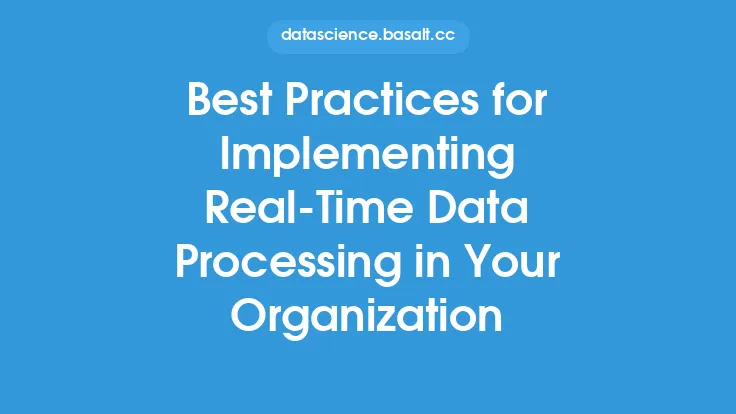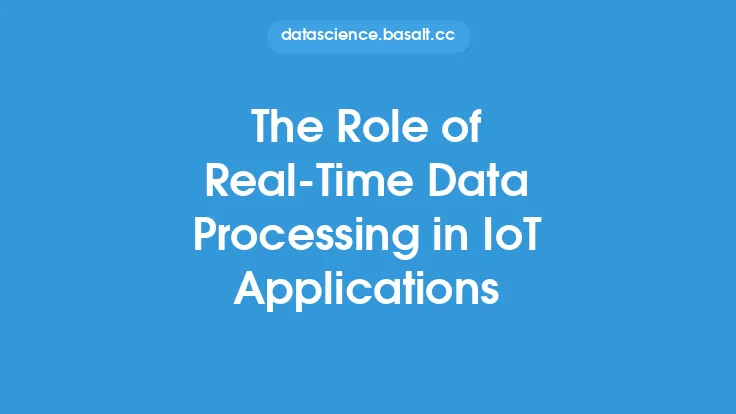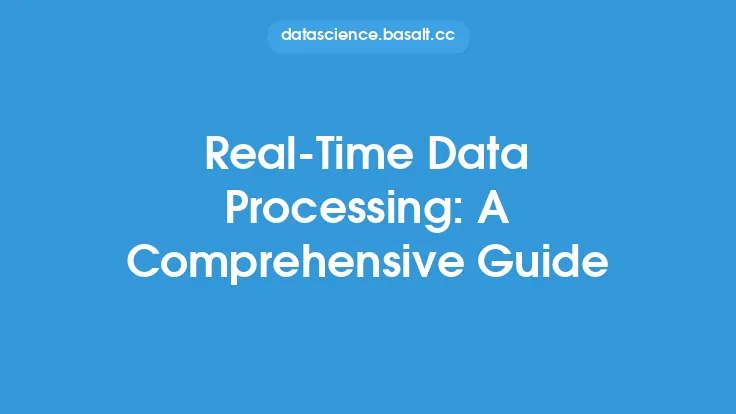Real-time data processing is a critical component of high-performance applications, enabling organizations to respond quickly to changing conditions, make informed decisions, and gain a competitive edge. As the volume and velocity of data continue to increase, optimizing real-time data processing has become a key challenge for data engineers and architects. In this article, we will delve into the world of real-time data processing, exploring the concepts, techniques, and technologies that can help optimize performance and unlock the full potential of high-performance applications.
Introduction to Real-Time Data Processing
Real-time data processing refers to the ability to process and analyze data as it is generated, in real-time, without delay or batch processing. This enables organizations to respond to events, make decisions, and take actions in a timely manner, which is critical in applications such as financial trading, IoT sensor processing, and social media analytics. Real-time data processing involves a range of technologies and techniques, including data ingestion, processing, and analytics, as well as data storage and retrieval.
Key Challenges in Real-Time Data Processing
Optimizing real-time data processing is a complex task, and several challenges must be addressed to achieve high-performance and low-latency processing. Some of the key challenges include:
- Handling high-volume and high-velocity data streams: Real-time data processing requires the ability to handle large volumes of data, often with high velocity and variability.
- Ensuring low-latency processing: Real-time data processing requires fast processing and analysis, often with latency requirements measured in milliseconds or microseconds.
- Providing fault-tolerant and scalable architectures: Real-time data processing requires architectures that can scale to handle changing workloads and provide fault-tolerant operation to ensure continuous processing.
- Managing data quality and integrity: Real-time data processing requires mechanisms to ensure data quality and integrity, including data validation, cleansing, and transformation.
Optimizing Real-Time Data Processing
To optimize real-time data processing, several techniques and technologies can be employed. Some of the key strategies include:
- Using in-memory computing: In-memory computing can provide significant performance improvements by reducing the need for disk I/O and enabling faster data processing.
- Leveraging parallel processing: Parallel processing can help to speed up data processing by dividing tasks into smaller, independent chunks that can be executed concurrently.
- Implementing data caching: Data caching can help to reduce latency by storing frequently accessed data in memory, reducing the need for disk I/O.
- Using specialized hardware: Specialized hardware, such as graphics processing units (GPUs) and field-programmable gate arrays (FPGAs), can provide significant performance improvements for certain types of data processing tasks.
Real-Time Data Processing Architectures
Real-time data processing architectures can be designed using a range of technologies and frameworks, including:
- Lambda architecture: The lambda architecture is a popular design pattern for real-time data processing, which involves using a combination of batch and stream processing to provide both high-throughput and low-latency processing.
- Kappa architecture: The kappa architecture is a variation of the lambda architecture, which uses a single stream processing pipeline to provide both real-time and batch processing.
- Microservices architecture: Microservices architecture can be used to design real-time data processing systems, which involve breaking down the system into smaller, independent services that can be developed, deployed, and scaled independently.
Real-Time Data Processing Tools and Technologies
A range of tools and technologies are available to support real-time data processing, including:
- Apache Kafka: Apache Kafka is a popular messaging system that can be used to build real-time data processing pipelines.
- Apache Storm: Apache Storm is a distributed stream processing framework that can be used to build real-time data processing applications.
- Apache Flink: Apache Flink is a distributed stream processing framework that can be used to build real-time data processing applications.
- Apache Beam: Apache Beam is a unified programming model for both batch and stream processing, which can be used to build real-time data processing applications.
Best Practices for Optimizing Real-Time Data Processing
To optimize real-time data processing, several best practices can be employed, including:
- Monitoring and logging: Monitoring and logging are critical for identifying performance bottlenecks and optimizing real-time data processing systems.
- Testing and validation: Testing and validation are essential for ensuring that real-time data processing systems are functioning correctly and providing accurate results.
- Scalability and flexibility: Real-time data processing systems should be designed to scale and adapt to changing workloads and requirements.
- Data quality and integrity: Data quality and integrity are critical for ensuring that real-time data processing systems are providing accurate and reliable results.
Conclusion
Optimizing real-time data processing is a critical challenge for data engineers and architects, requiring a range of techniques, technologies, and best practices to achieve high-performance and low-latency processing. By understanding the key challenges and opportunities in real-time data processing, and by employing strategies such as in-memory computing, parallel processing, and data caching, organizations can unlock the full potential of their high-performance applications and gain a competitive edge in today's fast-paced and data-driven world.





